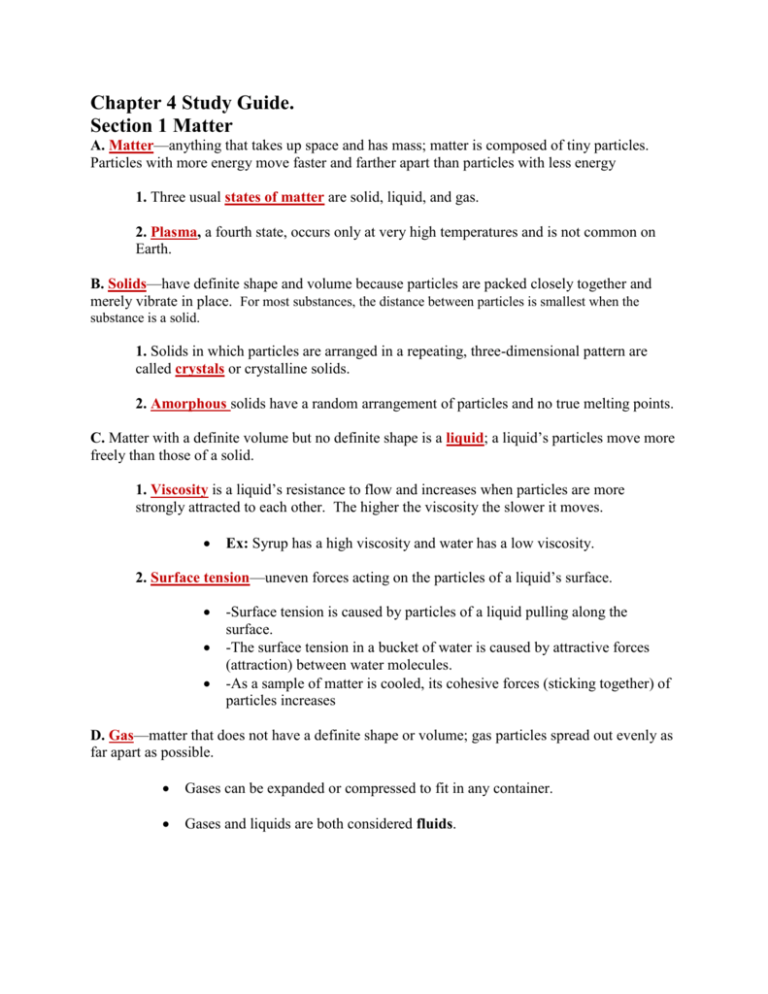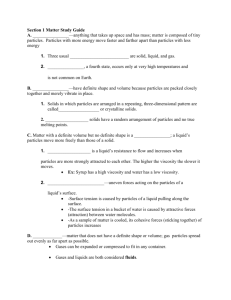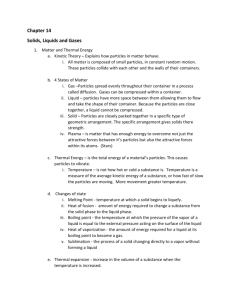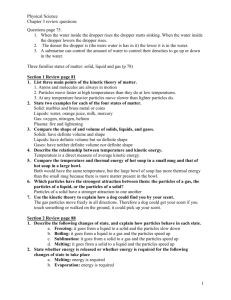Ch 4 Study Guide wit
advertisement

Chapter 4 Study Guide. Section 1 Matter A. Matter—anything that takes up space and has mass; matter is composed of tiny particles. Particles with more energy move faster and farther apart than particles with less energy 1. Three usual states of matter are solid, liquid, and gas. 2. Plasma, a fourth state, occurs only at very high temperatures and is not common on Earth. B. Solids—have definite shape and volume because particles are packed closely together and merely vibrate in place. For most substances, the distance between particles is smallest when the substance is a solid. 1. Solids in which particles are arranged in a repeating, three-dimensional pattern are called crystals or crystalline solids. 2. Amorphous solids have a random arrangement of particles and no true melting points. C. Matter with a definite volume but no definite shape is a liquid; a liquid’s particles move more freely than those of a solid. 1. Viscosity is a liquid’s resistance to flow and increases when particles are more strongly attracted to each other. The higher the viscosity the slower it moves. Ex: Syrup has a high viscosity and water has a low viscosity. 2. Surface tension—uneven forces acting on the particles of a liquid’s surface. -Surface tension is caused by particles of a liquid pulling along the surface. -The surface tension in a bucket of water is caused by attractive forces (attraction) between water molecules. -As a sample of matter is cooled, its cohesive forces (sticking together) of particles increases D. Gas—matter that does not have a definite shape or volume; gas particles spread out evenly as far apart as possible. Gases can be expanded or compressed to fit in any container. Gases and liquids are both considered fluids. Section 2 Changes of State A. Particles are in constant motion; amount of movement depends on their kinetic energy. Energy is the ability to do work or cause change. Kinetic energy is the energy of motion. 1. Thermal energy—total energy of all the particles in a sample of matter A warmer substance has more thermal energy than a cooler one. 2. The average kinetic energy of particles in a substance is its temperature. 3. Heat—movement of thermal energy from a substance with a higher temperature to one with a lower temperature. Heat moves in or out of a substance during a change of state B. Specific heat—amount of heat needed to raise the temperature of 1 g of a substance 1°C A substance with a high specific heat takes more heat to raise its temperature one degree Celsius. C. Matter can change states as energy is absorbed or released. 1. A change from the solid to the liquid state is called melting. When a material is melting, the temperature remains the same. 2. A change from the liquid to the solid state is called freezing. The melting point of a substance is the same as its freezing point. D. Changes between liquid and gas states 1. A change from liquid to gas is called vaporization. The rate of evaporation of a liquid decreases as the temperature decreases. a. Boiling is vaporization which occurs below the liquid’s surface at its boiling point. b. Evaporation is vaporization which occurs at the surface of a liquid; molecules must be at or near the surface at the right speed to evaporate. 2. Condensation—a change from gas to liquid E. Changes from a solid directly to a gas state is called sublimation—During sublimation the surface particles of a solid gain enough energy to become a gas. Section 3 Behavior of Fluids A. Pressure is the force exerted on an area. Pressure equals the force exerted on a surface divided by the total area over which the force is exerted or, P = F / A. The newton is a unit of force. 1. If force increases over an area, the pressure increases; if force over an area decreases, the pressure decreases. 2. Atmospheric pressure—air presses down on Earth with force. Atmospheric pressure is 101.3kilopascals. For a straw to work, the atmospheric pressure pushes down on the liquid's surface 3. Pressure can be balanced as the pressure pushing down equals the pressure pushing up. 4. As altitude increases, air pressure decreases. B. Gas pressure in a closed container changes with volume and temperature changes. 1. Decreasing volume increases pressure; increasing volume decreases pressure. Increasing temperature increases pressure; decreasing temperature decreases pressure. Tires on a bicycle heat up as they are ridden causing the pressure to increase inside the tire. If a container of gas gets larger while the temperature remains the same, the pressure decreases. C. Buoyant force—an upward force on an object immersed in a fluid. The force of the liquid pushing up an object is caused by buoyant force. An object is able to float on water if it less dense than the water 1. Archimedes’ principle—helps to explain the relationship between buoyancy and density. Buoyant force on an object is equal to the weight of the fluid displaced by the object. 2. Density is mass divided by volume. D= M/V a. An object will float in a fluid that is denser than the object. Because lead has a lower density than liquid mercury, it will float in mercury. b. An object with the same density as the fluid will stay at the same level in the fluid. c. An object will sink in a fluid that is less dense that the object. D. Pascal’s principle—When a force is applied to a confined fluid, an increase in pressure is transmitted equally to all parts of the fluid. Pascal's Principle can be applied to any matter that can flow. 1. Hydraulic systems allow people to lift heavy objects with relatively little force. 2. When squeezed, liquids will be pushed out of a force pump, a closed container with a hole in it.











